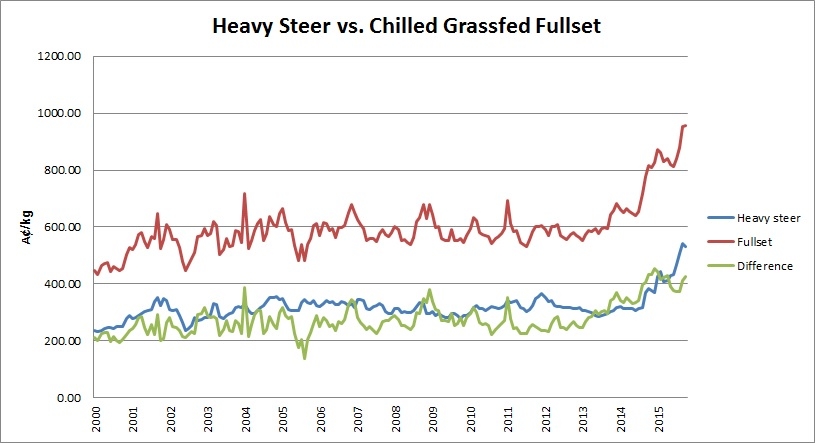Subscribe to The Weekly e-newsletter
For in-depth red meat market news, information and analysis.
Queensland heavy OTH indicator lagging fullsets
09 November 2015
The difference between the Queensland over-the-hook (OTH) heavy steer indicator and chilled grassfed fullset indicator to Japan during September and October was especially wide (410A¢ and 425A¢/kg, respectively) in historical terms.
Underpinning the margin was the higher price for fullsets, bucking most other global beef price trends. The indicator has benefited from favourable currency movements and likely signifies a larger upward price trend for chilled beef.
The Queensland OTH heavy steer indicator (300-400 kg A-C) and chilled grassfed fullset indicator tracked at an average 260A¢ difference for the period 2000 to 2012.
The difference between the two is made up of processing and shipping costs, importer/exporter revenue, currency fluctuations, tariffs and competitiveness with other suppliers and proteins.

In more recent years this margin has spread, underpinned by strong global meat prices causing the fullset indicator to rise sharply, while Australian cattle prices lagged as a result of drought. This was particularly noticeable in 2013 and 2014, while the first half of 2015 saw the spread narrow slightly – largely due to the sharp rise in the Australian cattle market.
The last few months have been very interesting though, as the spread between the two indicators has again increased. This is the reverse to the US imported 90CL to Australian saleyard medium cow indicator relationship, where the difference between the two is narrowing towards the longer term average, as a result of the deteriorating US beef market.
It is worth noting that chilled grassfed fullsets to Japan are no longer traded in the same quantities as years gone by, accounting for just 2% of trade to Japan over the past five years compared to 5-8% between 2000-2005. Furthermore, as illustrated in the chart above, the fullset indicator tends to be more volatile than the OTH indicator.
However, the long-standing relationship between the two indicators provides a clue for further potential in the Queensland heavy steer OTH indicator.
Considering the diminishing pool of cattle, prolonged drought conditions, and the large number processed at a younger/lighter age, heavy cattle availability will continue to be difficult to source, adding further support for prices.


